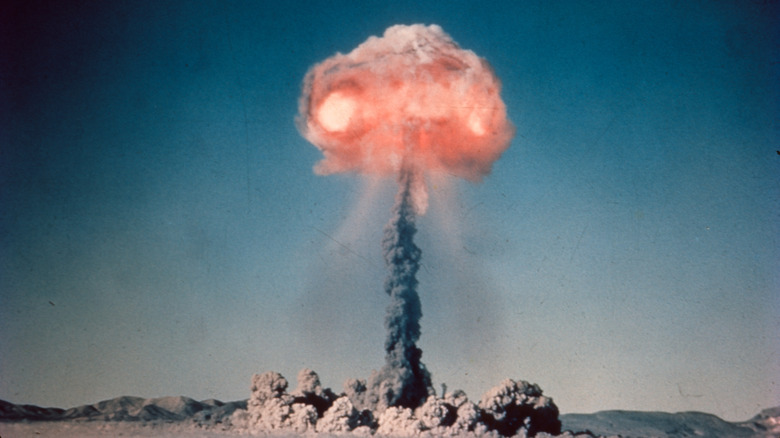Here's What A Nuclear Bomb Actually Sounds Like
Nuclear weapons have long captured the imagination and fear of humanity and resulted in several countries preparing for the worst. When first developed at the tail end of World War II, nuclear weapons represented a shift in warfare that saw potential destruction on a dangerous and unprecedented level. While conventional weapons were destructive in ground combat, nuclear weapons had the ability to completely destroy everything, wherever they were aimed, and after the United States and Soviet Union stockpiled thousands of these apocalyptic weapons, many feared that the end would come in the form a global nuclear flash that would devastate all life.
While these weapons exist but aren't used, many may wonder what they actually sound like, considering nuclear explosions have been featured prominently in numerous movies and television shows. Though entertainment often portrays these weapons with fantastic and intense sound effects, the reality is much more mundane, and a nuclear explosion simply sounds like a normal explosion — that is an initial intense thunderclap and growing rumble as the destruction levied by the nuclear weapon radiates out.
What does a nuclear bomb sound like?
Using footage of the Upshot–Knothole Annie test detonation, in the above video, you can see the foreboding mushroom cloud first before the jarring and incredibly loud sound of the weapon's detonation. The reason for this is because the varying speeds of sound and light, which means that at a distance, you would see a nuclear weapon's resulting flash and mushroom cloud before the sound reaches you. After the arrival of this initial sound though, a growing rumbling is heard, which is truly impressive considering the distance from which the above video is being taken.
Speaking with NPR, science historian Alex Wellerstein described the test footage of the very first nuclear bomb by saying, "Murmurs in anticipation; the slow countdown over a megaphone; the reaction at the flash of the bomb; and finally — a sharp bang, followed by a long, thundering growl. That's the sound of the bomb."
Most of the energy released by a nuclear bomb is broken down into three categories, which are blast energy, nuclear radiation, and thermal energy. Half of a nuclear bomb's output comes from the initial blast reaction, while the remaining is 35% thermal energy and 15% nuclear radiation. Nuclear bombs are measured by their yield as it is compared to conventional TNT explosives, meaning that a one kiloton nuclear bomb has the same amount of energy as 1,000 tons of TNT. In other words, even though nuclear weapons utilize nuclear fission as their primary mechanism, the results still sound like a conventional explosion, albeit on a significantly larger scale.
